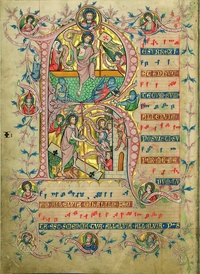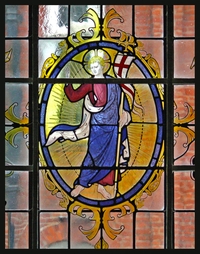
Easter, intense tide, intense songs
Author: Mr. Jean-Pierre Exter
 With the Easter Introit, Antiphona ad Introitum, one could expect to find songs of jubilee and trumpet call.
However with the Introit Resurrexi the unknown author from the early Middle Ages doesn't choose a sparkling
piece of music but a conversation between the Son and the Father. The melody he uses fits this dialogue
perfectly, a metaphysical dialogue that is hard to grasp for us humans.
With the Easter Introit, Antiphona ad Introitum, one could expect to find songs of jubilee and trumpet call.
However with the Introit Resurrexi the unknown author from the early Middle Ages doesn't choose a sparkling
piece of music but a conversation between the Son and the Father. The melody he uses fits this dialogue
perfectly, a metaphysical dialogue that is hard to grasp for us humans.
At a few places only in the Gregorian chants, one finds a conversation between the Father and the Son, as for instance the Introit of the Christmas midnight Mass Dominus dixit ad me: The Lord spoke to me. These conversations are for intense tides, here Christmas tide and Easter tide.
In these examples the authors choose modest, temperate almost discreet melodical accompaniment. The interval between the notes is rarely more than three tones. That's just the core of Gregorian singing: the notes and neums are chosen to support the words and not the other way around.
The melody of the Easter Introit may seem monotonous but through the words it gets more content than a momentary jubilation, it goes deeper, right into the heart and the soul and is like the conversation between the Son and the Father: a moment of intimacy and eternity.
 Ant. Resurréxi,
et adhuc tecum sum, allelúia, posuísti super me manum tuam, allelúia, mirábilis facta est sciéntia tua,
allelúia, allelúia.
Ant. Resurréxi,
et adhuc tecum sum, allelúia, posuísti super me manum tuam, allelúia, mirábilis facta est sciéntia tua,
allelúia, allelúia.
Ps. Dómine probásti me, et cognovísti me, tu cognovísti sessiónem meam et resurrectiónem meam.
Ant. I arose, and am still with Thee, alleluia.
Thou hast laid Thine hand upon me, alleluia.
Thy knowledge is become wonderful, alleluia.
Ps. Lord, Thou hast searched me and known me;
Thou knowest my sitting down and my rising up.
[Translation from ChoralWiki]
Not only the Introit but also the Gradual Haec dies is special because of its melody that is nearly the same as the one of the Gradual Requiem aeternam from the Mass of the dead, except for a few notes at the start of the piece. At the time the melody was presumably well known and for that reason, obviously not because of the words, it was used at Easter High Mass. Moreover there are 26 Graduals with that very melody in the 1974 Graduale Romanum chants book but each one with different words.
The Antiphon Vidi aquam is a jewel but is sung in Easter tide not so often. After the renewal of the baptismal promises those present are aspersed with the newly consecrated water and Vidi aquam is sung. The visionary words are taken from the Prophet Ezechiel chapter 47: it is a symbol of baptism, fecundity, gratitude and the lateral wound of the crucified Christ.
Vidi aquam egredientem de templo a latere dextro, alleluia,
et omnes ad quos pervenit aqua ista, salvi facti sunt,
et dicent, alleluia, alleluia.
I saw water flowing from the temple,
on the right side (Jesus' lateral cut wound by the spear), alleluia:
And all to whom that water came
have been saved,
and they will say, alleluia.
[Translation from ChoralWiki]
Easter 2019
Our commentators: